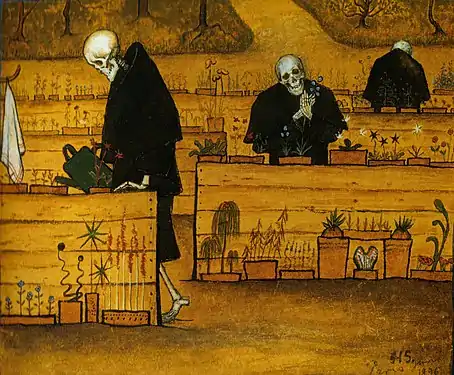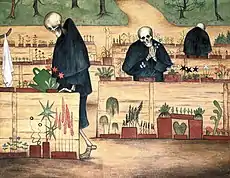The Garden of Death
The Garden of Death (Finnish: Kuoleman puutarha) (1896) is a painting by Finnish symbolist painter Hugo Simberg. Like many of Simberg's paintings, it depicts a gloomy, otherworldly scene. The central figures are reminiscent of the classic black-clad Grim Reaper, but paradoxically are tending to gardens; traditionally symbols of birth or renewal.
| The Garden of Death | |
|---|---|
 | |
| Artist | Hugo Simberg |
| Year | 1896 |
| Type | Watercolor and gouache |
| Dimensions | 16 cm × 17 cm (6.3 in × 6.7 in) |
| Location | Ateneum, Helsinki |
The Garden of Death is one of the few paintings whose symbolism Simberg explained; typically he preferred to let viewers come to their own conclusions. In a note on one sketch he described the garden as "the place where the dead end up before going to Heaven".[1][2] Simberg's juxtaposition of the traditionally frightening imagery of death with the tenderness and humor of his portrayal invite the viewer to consider mortality in a new light.[3]
The painting was a favored subject of Simberg's and he made several versions using different techniques, including larger fresco version of the painting in the Tampere Cathedral, which also contains other works by Simberg.[4][5]

References
- (in Finnish) Hugo Simberg at YLE.fi
- The Garden of Death at New York University's Art, Literature and Medicine Database
- The History, Art and Architecture of Tampere Cathedral
- "355. Hugo Simberg (1873-1917) Kuoleman puutarha". Hagelstam. Retrieved 4 July 2020.
- Ruuska, Helena (2018). Hugo Simberg: pirut ja enkelit. Werner Söderström. ISBN 9789510421826.